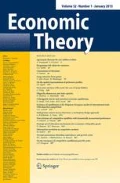Summary.
This paper considers a monetary growth model in which banks provide liquidity, and in which a government finances a deficit by printing money and selling bonds. In this context, I examine the possibility that the government may want to impose binding reserve requirements on banks' holdings of both money and government bonds. Conditions are established under which doing so increases steady state welfare and reduces the scope for indeterminacies. Furthermore, under a binding system of multiple reserve requirements we have that money is superneutral. On the other hand, if reserve requirements are imposed on cash holdings alone, increases in the steady state inflation rate adversely affect capital accumulation and long run real activity. Thus systems of multiple binding reserve requirements can insulate real activity from the consequences of inflationary taxation.
Similar content being viewed by others
Author information
Authors and Affiliations
Additional information
Received: June 30, 2000; revised version: January 31, 2001
Rights and permissions
About this article
Cite this article
Gomis-Porqueras, P. Multiple reserve requirements in a monetary growth model. Econ Theory 19, 791–810 (2002). https://doi.org/10.1007/s001990100180
Issue Date:
DOI: https://doi.org/10.1007/s001990100180




